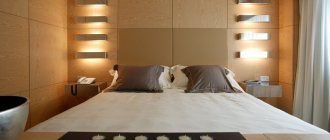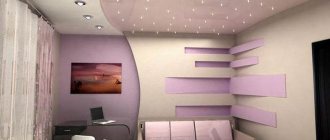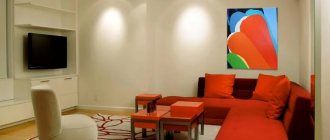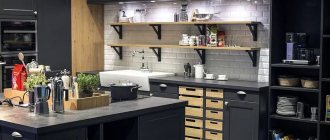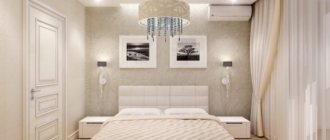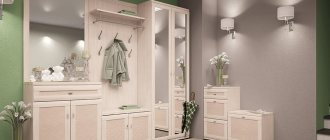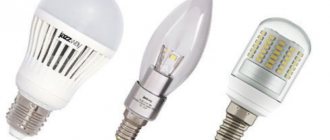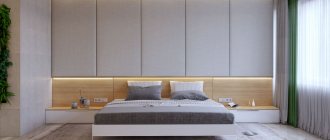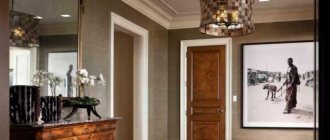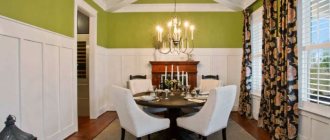Stretch ceilings are the personification of coziness, beauty and comfort in modern apartments. Undoubtedly, this is an excellent design option for any room. High-quality light is a very important factor, so it is necessary to organize it correctly. The location of the light bulbs on the suspended ceiling plays an important role in this.
Lamp placement options
- Oval . The devices are placed on the ceiling surface in the form of a small oval. There is empty space in the center. If necessary, you can place an original chandelier in the central part, which will make the design even more attractive.
- Circle. By placing the devices in the shape of a circle, you will be able to illuminate the center well. At the same time, there will not be enough lighting in the corners, so you should worry about additional light sources.
- Corner location. This option is suitable if you plan to place a chandelier, otherwise the lighting will be very weak.
- Two semicircles . The corners of the room will be illuminated as much as possible. Also, be sure to install a chandelier in the center of the ceiling.
- Cross-shaped arrangement. By choosing this method, you don’t have to worry about the lack of a chandelier. The lighting will already be bright enough; you won’t need to supplement it.
- Rectangle . This method is suitable if you need to make a narrow room visually wider.
- Arc. An excellent option if you plan to divide the room into zones.
We should not forget that a spot device illuminates approximately 1.5 sq.m. premises. Let's say for a room with an area of 20 square meters. m, you will need approximately 10-12 light bulbs.
How to calculate the required number of spotlights
When developing a scheme, the question always arises: how many lamps are needed. In general, it is believed that 20 W are needed to illuminate one square meter of floor area. When calculating, you need to take into account how much lamp power you plan to use. If it is 30-35 W, then it turns out that one lamp can illuminate 1.5 squares (30 W / 20 W/m² = 1.5 m²). Next, divide the area of the room by 1.5, you get the number of lamps that will need to be installed for normal illumination. In this case, there will be enough light for full illumination.
The location of spotlights on the ceiling is not easy to choose
When drawing up a diagram for placing lamps on the ceiling, this number can be slightly adjusted in both directions, adjusting to the type of room. For example, for a bedroom the number can be reduced - it doesn’t require too much light, but for the living room or corridor you can increase it - here it’s better to have some excess. True, in this case it is advisable for the lamps to be turned on in parts - it is advisable to vary the degree of illumination. There should be at least two options: full and partial coverage. To do this, the lamps - through one or some other circuit - are connected to two switch keys.
When using incandescent lamps in spotlights, you can install a dimmer, which will allow you to smoothly change the brightness of the lighting by turning the knob. In general, there are many options. And we haven’t yet gotten to the layout of the spots on the ceiling.
Bedroom lighting
The placement of light bulbs on a suspended ceiling in the bedroom is a task that should be given maximum attention. The optimal solution for decorating this room is spotlights. They will create a bright, but at the same time unobtrusive light. It is better to place light bulbs around the perimeter of the ceiling.
Another original option is a chandelier in the center and a edging of light bulbs around the perimeter. Hidden lighting will look great. You can place it behind the eaves.
General recommendations for room lighting
Various types of devices are used for lighting. More traditional - chandeliers. According to the method of fastening, they are divided into suspended and overhead. The first are mounted on a hook, and the second - on a bar.
In recent years, indoor lighting in houses and apartments usually consists of two components - a chandelier, as the main source of light, and small spotlights that create a certain atmosphere or additionally illuminate certain areas in the room. In some cases, wall lamps and/or table lamps and floor lamps are also added. But the basis is usually ceiling lighting.
In addition to different shapes and sizes, you can also choose a different glow color
Traditionally, the location of the chandelier is strictly in the center of the ceiling. This rule is very rarely deviated from - then it is too difficult to create a harmonious design. The exception is a combined space in a studio apartment or kitchen-living room. In this case, a chandelier (usually one) is placed in the center of one of the zones, the rest are illuminated by spotlights or other light sources. The location of the lamps on the ceiling must be selected taking into account the design and geometry of the room. And it's not that simple.
Rules for placing spotlights
The placement of spotlights on the ceiling is a matter of imagination and taste, but you should not neglect the technical nuances. Firstly, they must be placed taking into account the required illumination of various parts of the room: more light is usually needed above the table, maybe above the seating area, etc. Although, if necessary, you can “gain” the missing brightness using floor, table or wall options. Secondly, spotlights must be installed taking into account safety requirements. This is especially true for suspended ceilings. They are made from materials that are temperature sensitive, and since most lighting fixtures get hot, this needs to be taken into account.
The best option is LED lamps. They do not heat up and light does not enter the ceiling space
Recessed spotlights are also called spots. This name is not so widespread, but it also occurs.
Here are the standards for installing spotlights on the ceiling:
- When placed along a wall, the minimum distance is 20 cm. If placed closer, the light is poorly diffused, and there is also a chance of “overheating” nearby walls.
- The minimum distance between two lamps is 30 cm, but in general it depends on the design, type of installation, and the material from which the ceiling is made.
In general, these are all general restrictions. They apply to both plasterboard and ordinary - bleached or painted - ceilings. Only tension ones have their own characteristics. We'll talk about this further.
Features of using recessed lamps on suspended ceilings
The main nuances are related to the fact that the materials from which suspended ceilings are made do not tolerate strong heat. Therefore, there are restrictions on the maximum power of the lamps used:
- incandescent lamps up to 40 W are placed on PVC film;
- halogen - up to 20 W;
- incandescent lamps up to 60 W;
Comparative characteristics of various lamps for recessed ceiling luminaires
Despite the fact that the power of the recommended lamps is different, the illumination will be almost the same, since halogen lights provide more light.
Another type of lamp that is used to illuminate a stretch ceiling is LED. There are no restrictions on power here - they practically do not heat up. But there is another “but” - to power such lamps a special adapter is required, but it gets hot. But the good news is that it can power a fairly large number of light bulbs. Well, it’s better to place it not on the ceiling, but in an accessible place - for easier repair or replacement.
What else can be used to illuminate the ceiling?
The next type of lamps is fluorescent. They are used quite infrequently - their appearance, to put it mildly, is “not quite”, and their dimensions are respectable. They just spoil the view. They can be mounted behind a stretch ceiling on the walls. In this case, the effect is very interesting - the diffused illumination is more intense near the walls, gradually tapering off to a minimum in the center.
Hidden lighting option in the corridor
In addition to fluorescent ones, there are long LED lamps. They can also be used for hidden lighting. This option is even better. Firstly, because LEDs have a longer service life, secondly, they practically do not heat up, and thirdly, they provide an even stream of light without the flickering inherent in fluorescent light sources. LED lighting has two disadvantages. The first has already been announced - special power supplies are needed. The second is the high price of the lamps themselves and the power supplies for them. But you can create very interesting compositions that are difficult to organize with other light sources.
Unusual ceiling lighting
There is also a subtype of them - economy lamps. They have a base like a regular one, with the same power consumption they provide more light, but they are large in size and do not have the ability to focus the flow of lighting.
What else can be used to illuminate the ceiling - neon tubes and LED strips. It is quite difficult to work with tubes, but you can connect LED strips yourself. Thanks to their flexibility, you can create interesting compositions.
Unusual options can be created using LED strips
There is one more requirement for the placement of lamps on a film ceiling - the minimum distance from the light source to the seam is 15 cm. It is impossible to get closer, since the joint may separate when heated.
Lighting in the hall
The hall is often large in size, so the lighting must be of high quality and bright. The optimal solution is to place lamps around the perimeter of the room and install a chandelier in the center. The arrangement of light bulbs on the suspended ceiling in the hall may be different, but a chandelier is a necessity. Without it, the room may seem gloomy, and spot devices will not be enough.
Exclusively spot lighting is suitable only if the hall is small in size.
Solutions for multi-level ceilings
With the help of stretched fabric you can implement a variety of ideas, but at the same time the selection and installation of lamps becomes more complicated. Here are the recommendations:
- Thanks to the levels, it is easy to zone a room to divide it into several areas with different lighting modes.
- The levels can be illuminated with LED strip to make the multi-level system more expressive.
- Spotlights are selected to match the ceiling design. For smooth curves, round and oval options are better suited. If the lines are strict and clear, you should choose options with a square or rectangular frame.
Spotlights highlight the beautiful curves of the multi-level structure. - It is best if the line of the lamps coincides with the bend of the multi-level structure.
Video block: Review of popular solutions for lighting suspended ceilings.
Making spot lighting in a suspended ceiling in a living room is not difficult if you understand its features. It is important to choose high-quality lamps and install them correctly, which will require preliminary preparation.
Hallway lighting
The hallway is often small and narrow, it is cramped and there is not enough light. To prevent this and ensure comfort in the room, you need to try to visually enlarge the space. This can be done using lighting fixtures.
It is better to choose glossy ceilings for the hallway, which perfectly reflect light. You can also install a small chandelier and several spotlights.
Options for lighting a room without a chandelier
Multi-level lighting
Experts recommend organizing four levels of room lighting:
- top – general light created by ceiling lighting devices;
- medium – local illumination of areas of the room, for example, with classic floor lamps. Light zoning both highlights areas of space and places emphasis on interior elements;
- lower - light sources are located at a distance of 50-100 cm from the floor level, for example, to illuminate stair steps. This also includes ice tape, which is mounted in specialized floor skirting boards;
- internal - illuminates the dressing room, cabinets, kitchen units, wall niches. It is implemented, as a rule, using single-color or multi-color LED strip.
Wall lighting
Wall sconces organically complement the general lighting, and often turn on completely autonomously.
Special lamp diffusers evenly distribute the glow, eliminating the blinding effect. The resulting spot light is quite sufficient for reading, working with a laptop or knitting.
Movable lighting fixtures
This is a special category of lamps that allow you to change the direction of the light beam. These include spots that rotate in horizontal and vertical planes. As well as track systems with a busbar along which mini spotlights move. Through the use of these devices, accent lighting is created that can be easily changed if necessary.
Bathroom lighting
Spotlights that are mounted into the structure are great for the bathroom. The distance between the lamps should be the same. To illuminate a small bathroom, 4-6 spot lamps are enough.
When choosing, it is worth considering that the bathroom is humid and damp, so you need to select devices that are not afraid of moisture.
Additional lighting devices
They are installed in a corner for reading, handicrafts, when light accents and highlighting of bright interior items are needed - for example, paintings, stucco moldings, decorations, etc. These are:
- Wall lights . They can be built-in or overhead (sconces), in design - armature, wall-mounted (used in a narrow space, as a backlight for pictures), stationary, adjustable, with a reflected and directed beam. When the main lighting is turned off, sconces create a cozy atmosphere; they are installed near the reading chair to emphasize the interesting texture and stucco molding. Wall sconces in the work area replace a table lamp. When placing sconces, you need to make sure that they do not interfere with the passage.
- Floor lamps . This is the common name for a floor lamp. Typically, such a device has a leg (straight, curved, or even adjustable in height or offset). Thanks to the lampshade and diffuser, the device produces dim, diffused light. The beam is directed up or down, in both directions. But the cap is an optional attribute; models are produced without this detail. Floor lamps can be stationary or portable, with one or more lamps.
- Bottom lighting . Floor-recessed lamps are still rarely used, although they look very impressive, especially in recreation rooms. They are usually built into podiums - like ceiling “points”.
- Desk lamp . They are also placed on the fireplace, bedside tables, near the sofa if they are working on it, etc.
- Optical fiber . This light source is economical and, most importantly, safer than its analogues. It can be used even in damp areas. Optical fiber emits light in transverse and lateral projection. This allows you to create a variety of compositions - for example, the popular “starry sky”. The fiber is cut even when it is turned on - no current is transmitted through it. Although the material is used for the main lighting, its task is still auxiliary lighting.
Organization of light in the kitchen
The correct placement of light bulbs on a suspended ceiling in the kitchen will help divide the room into zones. By placing several spotlights on both sides of the ceiling, you can make the room visually wider.
If the kitchen is large, lamps should be placed over the entire surface of the structure.
Using light, you can focus attention on certain areas, such as the kitchen stove or dining table.
How to choose
An important criterion when choosing lamps in the interior is their design, which is consistent with the style of the room. For a classic room, you can choose models with ornaments or crystal pendants. In a room with a modern design (modern, high-tech, loft) standard white lamps of a simple shape are suitable.
In addition to the appearance and material of the lampshade (it can be glass or acrylic), when choosing, pay attention to the following details:
- Design. If the ability to change the angle of light is important, pay attention to rotating lamps.
- Base type (usually GU10 or LED).
- Dust and moisture protection class. Important when installing in a bathroom, open veranda or kitchen.
- Possibility of changing the type of lamp (LED instead of halogen).
- Possibility of connecting a dimmer.
Basic rules for placement
- The chandelier is installed in the center of the room, and not in another part of the ceiling.
- You cannot place the light bulbs too close to the wall; you must make a retreat of at least 20 cm.
- The distance from the outer seam of the fabric to the location of the device should be 15 cm.
- One spotlight provides high-quality light over an area of 1.5 sq.m. Based on this indicator, it is necessary to select the number of lamps.
- There are no strict criteria regarding the distance of lamps from windows. It just depends on the owner's preferences and design.
High-quality light is the key to comfort in any room. By correctly and beautifully placing lighting fixtures on a tension structure, you can not only provide a pleasant atmosphere, but also make the interior even more attractive and harmonious.
Choosing a lamp for suspended ceilings
Separately, mention should be made of the power of lighting fixtures installed on tension fabrics. Since the latter are critical to a strong increase in temperature, a number of restrictions must be taken into account. For PVC films they are as follows:
- The power of a light bulb with an incandescent filament (FN) should not exceed 40 W.
- Halogen lamp – 20 W.
For satin fabrics:
- LN – no more than 60 W.
- Lamps for suspended ceilings with halogen lamps - maximum 35 W.
Nowadays, LED bulbs and strips are increasingly used, since their heat generation and energy consumption are significantly lower than other ceiling lamps with the same level of luminous flux. When organizing LED backlighting, it should be taken into account that to power the strips, special power supplies (drivers) are required, which must be placed in an accessible place. As for lamps of the same type, their drivers are built into the bases.
Rules for lighting a room without a chandelier
- The use of local and accent lighting helps to achieve the best illumination.
- Multi-level lighting is the most effective way to saturate a large area with light.
- LED lighting significantly reduces energy costs.
- Thoughtful distribution of light hides all the disadvantages of the room.
- Correct planning and placement of light accents emphasizes the advantages of the interior.
- Lighting can be adjusted by turning on/off “layers” of light or by dimming.
- Rooms with light decoration require a lower level of illumination, due to better reflection of the light flux from the surface.
Spot layouts with a chandelier
No matter how archaic a chandelier sometimes looks, sometimes without it some rooms look downright boring.
The use of spots as additional lighting does not at all downplay their role as light sources. As can be seen from the set of the most common schemes, they are responsible for zoning the room and the necessary lighting of certain areas noticeably distant from the central chandelier.
Let's look at how this is implemented in practice.
